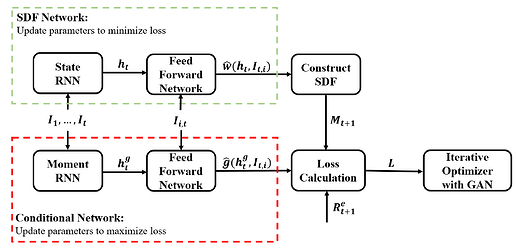I’m implementing the following architecture:
with loss:

Both the State and Moment RNN get the same input at time t and feed their hidden states to some Feed Forward Networks along with additional inputs (same for both FFN). Their output then is combined in a custom Loss function.
The whole network is then trained in an iterative way, i.e. 1000 epochs to train the SDF network with given conditional output (minimize loss), then 1000 epochs to train the conditional network given SDF output (minimize negative loss).
I’m not proficient in python (and pytorch), so this may not be best way to implement this:
ap = AssetPricer(2) # Asset Pricing Neural Network
ad = Adversary(2) # Adversary Neural Network
srnn = nn.LSTM(input_size=2, hidden_size=1, num_layers=1, dropout=0.95, batch_first=False)
mrnn = nn.LSTM(input_size=2, hidden_size=1, num_layers=1, dropout=0.95, batch_first=False)
optimizer_ap = optim.Adam(ap.parameters(), lr=0.001) # APNN optimizer
optimizer_ad = optim.Adam(ad.parameters(), lr=0.001) # ADNN optimizer
optimizer_srnn = optim.Adam(srnn.parameters(), lr=0.001)
optimizer_mrnn = optim.Adam(mrnn.parameters(), lr=0.001)
train_loss = []
SR = [] # Sharpe ratio
N_i = torch.Tensor(np.count_nonzero(X_train[:,:,1], axis=0)) # Normalization constant
def GMMLoss(M, F, G):
M = torch.Tensor(M).unsqueeze(1)
F = torch.Tensor(F).unsqueeze(1)
G = torch.stack(G)
R = X_train[:, :, 1] # matrix of t+1 returns, (T X N)
Z = (M * R).float() # matrix of t+1 returns x M, (T X N)
Q = torch.einsum('pnt,tn->pn', G.T, Z)
Q = N_i * Q
Q = torch.einsum('pn,pn->n', Q, Q) # squared vector norm
Loss = torch.dot((N_i/(N*T)), Q)
return Loss
# GAN training specs
gan_iter = [1000, 1000, 1000, 0]
sdf_range = list(range(len(gan_iter)))[0::2]
adv_range = list(range(len(gan_iter)))[1::2]
for i in range(len(gan_iterrations)):
for e in range(gan_iter[i]):
M = [] # SDF
F = [] # Tangency portfolio returns
G = [] # Tensor of moment conditions
for t in train_dates:
# XSReturns
rets = X_train[t,:,1].T
# State RNN
inputs_lstm = X_train[0:t+1,:,2:4]
out_s, _ = srnn(inputs_lstm)
h_t = out_s[-1,0,:]*torch.ones(N, 1)
# Moment RNN
out_m, _ = mrnn(inputs_lstm)
h_m = out_s[-1,0,:]*torch.ones(N, 1)
# Asset Pricer
x_t = X_train[t,:,0].unsqueeze(1)
inputs_ap = torch.cat((x_t, h_t), 1)
W = ap(inputs_ap).flatten()
W = W / W.sum()
# Adversary
inputs_ad = torch.cat((x_t, h_m), 1)
g = ad(inputs_ad)
G.append(g)
WR = torch.dot(W, rets)
M_t1 = 1 - WR
F.append(WR)
M.append(M_t1)
Loss = GMMLoss(M, F, G)
train_loss.append(Loss)
if i in sdf_range:
optimizer_ap.zero_grad()
optimizer_srnn.zero_grad()
Loss.backward()
optimizer_ap.step()
optimizer_srnn.step()
else:
optimizer_ad.zero_grad()
optimizer_mrnn.zero_grad()
(-Loss).backward()
optimizer_ad.step()
optimizer_mrnn.step()
Just to be sure:
- As long as the custom loss function contains only torch operations, everything should be fine, correct?
- Is my implementation of the iterative training acceptable or does this create problems where I might not see it yet?
if i in sdf_range:
optimizer_ap.zero_grad()
optimizer_srnn.zero_grad()
Loss.backward()
optimizer_ap.step()
optimizer_srnn.step()
else:
optimizer_ad.zero_grad()
optimizer_mrnn.zero_grad()
(-Loss).backward()
optimizer_ad.step()
optimizer_mrnn.step()
